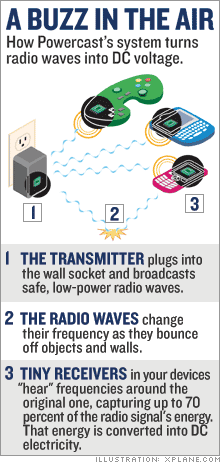
Wireless power transmission has been a moving target.One is typically accused of smoking something if the topic comes up :) However some breakthroughs are happening. This is very important for the low voltage lighting industry (aka LED lighting). Think of no wiring for you room lighting. The sources can be made portable and all that you need to do is ensure that it is within range of the transmitter. Will be a killer app for commercial and home lighting if there is no wiring to do ! From the CNN.com article:
How much money could you make from a technology that replaces electrical wires? A startup called Powercast, along with the more than 100 companies that have inked agreements with it, is about to start finding out. Powercast and its first major partner, electronics giant Philips, are set to launch their first device powered by electricity broadcast through the air.
It may sound futuristic, but Powercast's platform uses nothing more complex than a radio--and is cheap enough for just about any company to incorporate into a product. A transmitter plugs into the wall, and a dime-size receiver (the real innovation, costing about $5 to make) can be embedded into any low-voltage device. The receiver turns radio waves into DC electricity, recharging the device's battery at a distance of up to 3 feet.
Picture your cell phone charging up the second you sit down at your desk, and you start to get a sense of the opportunity. How big can it get? "The sky's the limit," says John Shearer, Powercast's founder and CEO. He estimates shipping "many millions of units" by the end of 2008.
For years, electricity experts said this kind of thing couldn't be done. "If you had asked me seven months ago if this was possible, I would have said, 'Are you dreaming? Have you been smoking something?'" says Govi Rao, vice president and general manager of solid-state lighting at Philips (Charts). "But to see it work is just amazing. It could revolutionize what we know about power."
So impressed was Rao after witnessing Powercast's demo last summer that he walked away jotting down a list of the industries to which the technology could immediately be applied: lighting, peripherals, all kinds of handheld electronics. Philips partnered with Powercast last July, and their first joint product, a wirelessly powered LED light stick, will hit the market this year. Computer peripherals, such as a wireless keyboard and mouse, will follow in 2008.
Broadcasting power through the air isn't a new idea. Researchers have experimented with capturing the radiation in radio frequency at high power but had difficulty capturing it at consumer-friendly low power. "You'd have energy bouncing off the walls and arriving in a wide range of voltages," says Zoya Popovic, an electrical engineering professor at the University of Colorado who works on wireless electricity projects for the U.S. military.
That's where Shearer came in. A former physicist based in Pittsburgh, he and his team spent four years poring over wireless electricity research in a lab hidden behind his family's coffee house. He figured much of the energy bouncing off walls could be captured. All you had to do was build a receiver that could act like a radio tuned to many frequencies at once.
"I realized we wanted to grab that static and harness it," Shearer says. "It's all energy."
No comments:
Post a Comment